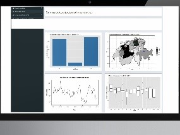New or well-known animal diseases may also occur or return at any time in Switzerland. But how does one spot the unexpected? The FSVO has supported a plurality of research projects on this topic. They investigated the suitability of routinely collected data on animal health for the early detection of animal diseases.
Searching for clues: How animal health data help to detect outbreaks of animal disease at an early stage

Although there are many surveillance programs in Switzerland, these programs cover only specific animal diseases and zoonoses: a fraction of all viruses, bacteria and parasites which could endanger the health of animals and humans. COVID-19 has clearly demonstrated how quickly a new pathogen can spread worldwide. Thus it is also essential to detect unexpected animal diseases at an early stage. Surveillance systems that investigate samples only for specific pathogens have only a limited use.
This is the crux of the matter
The research projects described below have the objective of preparing routinely recorded data on animal health and to combine the data with additional sources of information. This is intended to be able to detect outbreaks of animal disease in a manner that is as reliable, precise and early as possible.
Computerised reading of pathology reports
The investigation of dead animals is highly important for monitoring animal health. However, the results of such investigations are found in individually formulated texts. This is why there are different names for the same findings. Thus, scientists from the various technical fields of veterinary medicine and computer linguistics collaborated to develop an application that with the help of text-mining methods would render these data utilisable. Text-mining methods are capable of reading a text. They recognise those terms that belong together, even if they have been formulated differently. Thus, relevant findings can be combined into categories of syndromes.
After text-mining, these data were compared with clinical data from various sources. The comparison showed that only ca. 1% of all deceased cattle were pathologically examined. However, these cases arose in problematic farms. Among the farms that had sent animals for post mortem analysis, on average two animals had died and five had fallen ill. Moreover, thanks to the use of the pathology data, additional cases of abortion and stillbirths could be discovered which had not been reported in the clinical data.
Pathological examinations of dead animals thus proved to be a valuable source of information for monitoring animal health.
Linking up data helps the early recognition of outbreaks of animal disease
Another research project focused on linking up animal health data with information from the animal tracing database. The researchers developed and investigated various methodological approaches in order to detect outbreaks of animal diseases at an early stage.
Fortunately, there were no major outbreaks of animal disease in Switzerland in the investigation period. Therefore, the methods were tested with the aid of simulated outbreaks. All simulated outbreaks were detected in less than four months. In times without outbreaks of animal disease there were at most three false alarms per year. Infectious bovine rhinotracheitis (IBR) was the best detected animal disease. In contrast, bovine virus diarrhoea (BVD) was detected later and less securely.
Research provides decision-making bases
The research projects delivered important insights into the benefits and challenges of the timely analysis of animal health data for the early detection of outbreaks of animal diseases. Based on these principles the FSVO examined which elements of the developed approaches should be implemented in the future, in which form and with which partners.
More information
In detail
Application of text-mining tools for the use of pathology data in epidemiological surveillance and early detection of animal diseases
Post-mortem examinations deliver valuable clues on the causes of death and the state of health of animals. Veterinarians and farmers utilise this information for a diagnosis of the livestock and possible treatments. Pathology records are often in the form of text documents, thus making more comprehensive analyses difficult. The tool developed in this project enables this data to be read, to be categorised and evaluated in a standardised manner. It renders the data utilisable for the early detection of animal diseases.
Mapping of clinical data from cattle to data from pathology reports to gain information for surveillance of animal diseases through text- and data-mining
Early detection of outbreaks of animal disease can be improved by combining various data sources. In addition to pathology records, an important source of information is clinical data, collected from breeding and healthcare organisations. However, these data are based on a different nomenclature. The tool developed in the preceding project to evaluate pathology data was adapted to be able to also take clinical data into account, thereby enabling a common evaluation of both data sources.
Bayesian approaches for combining and interpreting the results of event detection algorithms from many varied real time data sources
There are a number of algorithms with which events such as outbreaks of animal disease may be detected in the data. Bayesian methods are used in this research work in order to analyse a plurality of data records and to interpret the results of various algorithms. These methods also allow the integration of expert knowledge and literature reports of animal diseases.
Last modification 14.06.2022




